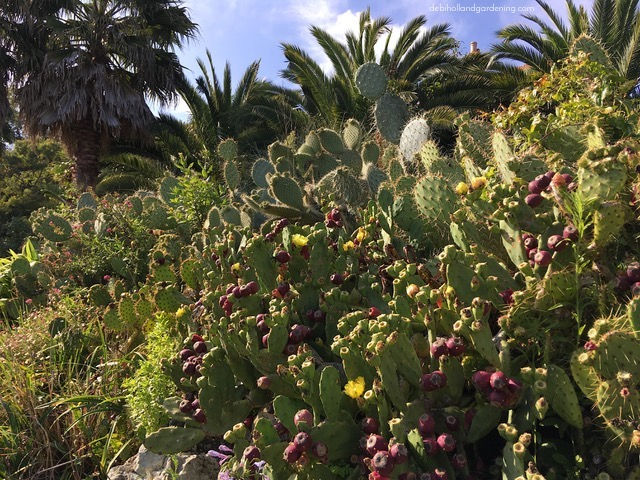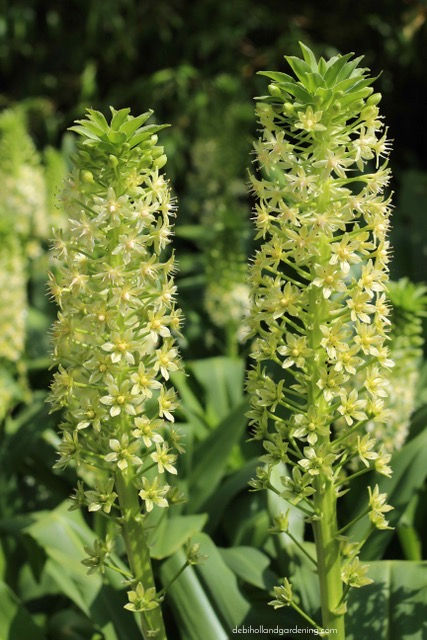Ventnor Botanic Garden
- Debi Holland

- Jan 9, 2021
- 6 min read
Updated: Jan 10, 2021

Summer 2019 we had a last minute trip to the Isle of Wight. I have only stepped foot on the Isle for one day when I was 15, on holiday with my best friend but it holds fond memories. A first for my husband and son, we all boarded the ferry with anticipation to explore the unknown.

What a gem of an island it is, like stepping back in time to holidays of my youth before the mainland hot spots got saturated. You can drive from one side of the island to the other in half an hour which is an unusual experience, particularly as, apart from in towns, you have the roads mainly to yourself.

I was overjoyed to discover there was a botanic garden on the island. Ventnor Botanic Garden. Britain's hottest garden. Boasting a microclimate of five degrees warmer than the mainland, this virtually frost-free garden is the gateway to tropical paradise and exceeded all expectations.

Former site of Victorian Royal National Hospital for Diseases of the Chest, Ventnor Botanic Gardens sits at Undercliff Drive on the clifftop of the Isle of Wight coast path above Steephill Cove and covers 22 acres of spectacular botanical delights including a palm garden.

Founded by Sir Harold Hillier in 1970, as Steephill Pleasure Gardens, it opened its doors in 1972 after the quarter of a mile long hospital was demolished in 1969. Run by the Isle of Wight Botanic Garden Society until 2000 when the gardens gained charitable status and is curated by Chris Kidd.

There are many historic wonders still remaining on site but a particularly unusual natural phenomenon awaited us, which could have easily been missed.

It is not everyday you visit a botanic garden and witness a 60 million year first!
Nestled, discreetly in a border was a Japanese Sago Palm, Cycas revoluta. It was such a striking plant I couldn't resist taking some time to photograph it from all angles...it was only later that day I discovered its significance. For the first time since the dinosaur age, there was the possibility to collect seed as male and females cones were produced at the same time.
Native to southern Japan, thriving in the Permian period and again now. Sadly an indication of climate change but a momentous occasion for horticulturalists. These primitive relations to conifers date back 280 million years!

Due to its unique microclimate the garden hosts many plants which could not survive outside in other parts of the United Kingdom, including holding the National Collection of half-hardy and hardy Puya. Exotic plants from South Africa, Japan, Australia and New Zealand thrive outdoors and keep visitors in a perpetual state of awe.

Cacti and succulents sprawl the hillside, their epic size a testament to the optimum growing conditions. Agaves languish next to prickly pears, bathed in palms.


The gardens have also been split in to exciting trails to add interest for different age groups and tastes to explore, including a champion trees, dinosaur and kids trail, lizard safari and the mysterious secret trail.

The secret trail points out some exquisite little spots that could be overlooked by hasty visitors. You certainly would not want to miss Bob's Tree Fern Utopia!

Or the Aussie Wilderness...


The hydrangea dell...

Or you can just marvel at the vast long borders reaching as far as your eye can see...


The Isle of wight is a hot spot for fossil hunting with over 20 different dinosaurs being found on the island and the gardens grow many living fossils of this era in the grounds from Gingko bilobo to Araucaria araucana, Monkey Puzzle, Wollemia nobilis, Wollemi Pine to Dicksonia antarctica, Tree Ferns.

Whatever your age, I don't think anyone can resist a secret passage in a garden, particularly one that leads to a beach! I was captivated by this deep tunnel under the ground which leads to a cliff top descending down onto the crystal blue waves below. Access is only available with a guide.

Imagine the secrets and adventures this tunnel must have been witness to over the years. This is straight out of an Enid Blyton book! BUT it has a less than romantic history in reality - after much speculation it is presumed it was most likely used as a rubbish shute and staggeringly rubbish was moved along the 350 foot vaulted ceiling tunnel by tram cart and dumped, unceremoniously straight in to the sea!

This is not the only secret tunnel at Ventnor, one was also discovered leading from an abandoned nursing home over the road... the former nurses home has a door under the stairs which leads you way under ground and under the main road, sadly bricked up long ago and as of yet the precise exit point on the garden's side has not been located but how intriguing!

You can also go down into the mushroom fruiting chamber, for free, every day at 2.45pm and see Shitake (Lentinula edodes), Yellow and Red Oyster (Pleurotus ostreatus) growing and of course sample these edible mushrooms - sadly this was shut when I was there but this gives me a great excuse to return... as if I needed an excuse?
Once you have experienced all these dark dank tunnels you can get back to the wall-to-wall sunshine and enjoy the explosion of tropical colour.

Striking Canna foliage rises up from a sea of perennials and tropical spikes, reminiscent of hot summers spent in the south of France.

Ventnor pride themselves in their 'rock star' plants. The show offs who steal the show, strutting their stuff round the borders. Echium pininata, Tree echium, Kniphofia, Red hot pokers and Puya.


And of course Agapanthus which is absolutely prolific throughout the garden.


Another highlight is Ventnor's Glasshouse.

The glasshouse is home to the prestigious giant Amazonian waterlily which is grown from seed every year. This plant seems to defy gravity and can carry the weight of us humans! This fast growing plant transforms from the size of a pea to a 10m platform in a few months.

A film crew were present when I visited and had rigged up cameras to capture the moment when the Victoria amazonica flowers bloomed. The white female lily opens after midnight to attract scarab beetles into its petals and trap them for pollination. The flower only opens again on the following night once pollination has taken place and the lily has changed sex to male and colour to red. An incredible natural phenomenon.

All the garden zones link with a series of stone arches, pergolas, natural foliage tunnels and trees. Areas cleverly elude to being larger than reality by using borrowed landscapes of the tree canopies, at times giving you the feel of being in the depths of a tropical jungle whereas you could be a short walk from the car park.

Each corner peeks into another region which tempts you to continue your exploration.

Linking the Australian Wilderness and Palm Garden is an ethereal floral archway, steeped in Campsis. This leafy umbrella poses a welcomed shade from the beating midday sun.

The foliage dripping archway is also home to the spectacular fire-red Abutilion bloom named by curator Chris Kidd 'Liza Roja' after his partner.

In 2009 Ventnor returned to the island's roots of hop growing. In days gone by the Isle of Wight was the fifth largest hop producing county in the UK but over time this fizzled out. Now the south gardens have a flourishing yard where the hops are hand picked and made into the garden's own ale range.
In 2013 the Garden launched Original Botanic Ale, brewed by Yates’ Brewery followed by Botanic Pale Ale in 2015 and their first eucalyptus lager in 2017 brewed by Goddard’s Brewery. I can voucher for them being a taste sensation.

Ventnor's history has a heritage with health. The former hospital was where people came to recuperate by the coast and escape city smog. Based at such a tranquil location Ventnor now offers wellbeing classes in yoga, tai chi and Qigong.

You can also enjoy healthy locally sourced food at the edulis restaurant cooked by Head Chef Brad Roe; many of the fresh ingredients such as vegetables, micro-greens and mushrooms are grown at the gardens. It would be hard to feel stressed at Ventnor - it is the epitome of calm.

Ventnor embraces the healing power of nature to sooth the mind and we could all certainly do with a bit of that at the moment!

Whether it is simply wandering through the 22 acres of escapism, browsing the herb and medicinal garden, attending courses, volunteering or sampling the culinary treats, the scale and diversity of plants grown at Ventnor is impressively captivating and will keep you eager for a return visit.
This is a garden very close to my heart. I am smitten.

For further details see: Ventnor Botanic Garden website
All photos © Debi Holland 2021







Comments